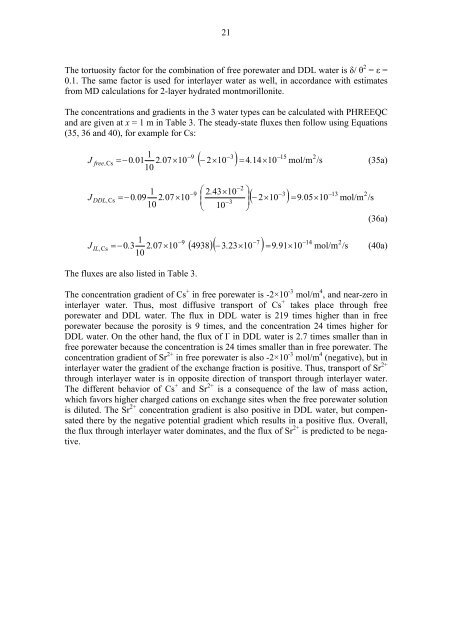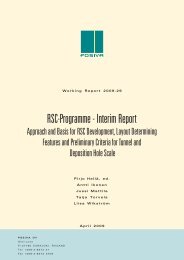A review of porosity and Diffusion in Bentonite (pdf) (2.4 MB) - Posiva
A review of porosity and Diffusion in Bentonite (pdf) (2.4 MB) - Posiva
A review of porosity and Diffusion in Bentonite (pdf) (2.4 MB) - Posiva
You also want an ePaper? Increase the reach of your titles
YUMPU automatically turns print PDFs into web optimized ePapers that Google loves.
21The tortuosity factor for the comb<strong>in</strong>ation <strong>of</strong> free porewater <strong>and</strong> DDL water is δ/ θ 2 = ε =0.1. The same factor is used for <strong>in</strong>terlayer water as well, <strong>in</strong> accordance with estimatesfrom MD calculations for 2-layer hydrated montmorillonite.The concentrations <strong>and</strong> gradients <strong>in</strong> the 3 water types can be calculated with PHREEQC<strong>and</strong> are given at x = 1 m <strong>in</strong> Table 3. The steady-state fluxes then follow us<strong>in</strong>g Equations(35, 36 <strong>and</strong> 40), for example for Cs:3152210 4 1410mol/m /s19free Cs 0.01 2.0710.(35a)10J ,J DDL , Cs219 2 43 10 0 09 2 07 10 . . . 31010. 3132210 90510mol/m /s(36a)197142IL Cs 0.3 2.071049383.2310 9.9110mol/m /s (40a)10J ,The fluxes are also listed <strong>in</strong> Table 3.The concentration gradient <strong>of</strong> Cs + <strong>in</strong> free porewater is -2×10 -3 mol/m 4 , <strong>and</strong> near-zero <strong>in</strong><strong>in</strong>terlayer water. Thus, most diffusive transport <strong>of</strong> Cs + takes place through freeporewater <strong>and</strong> DDL water. The flux <strong>in</strong> DDL water is 219 times higher than <strong>in</strong> freeporewater because the <strong>porosity</strong> is 9 times, <strong>and</strong> the concentration 24 times higher forDDL water. On the other h<strong>and</strong>, the flux <strong>of</strong> I - <strong>in</strong> DDL water is 2.7 times smaller than <strong>in</strong>free porewater because the concentration is 24 times smaller than <strong>in</strong> free porewater. Theconcentration gradient <strong>of</strong> Sr 2+ <strong>in</strong> free porewater is also -2×10 -3 mol/m 4 (negative), but <strong>in</strong><strong>in</strong>terlayer water the gradient <strong>of</strong> the exchange fraction is positive. Thus, transport <strong>of</strong> Sr 2+through <strong>in</strong>terlayer water is <strong>in</strong> opposite direction <strong>of</strong> transport through <strong>in</strong>terlayer water.The different behavior <strong>of</strong> Cs + <strong>and</strong> Sr 2+ is a consequence <strong>of</strong> the law <strong>of</strong> mass action,which favors higher charged cations on exchange sites when the free porewater solutionis diluted. The Sr 2+ concentration gradient is also positive <strong>in</strong> DDL water, but compensatedthere by the negative potential gradient which results <strong>in</strong> a positive flux. Overall,the flux through <strong>in</strong>terlayer water dom<strong>in</strong>ates, <strong>and</strong> the flux <strong>of</strong> Sr 2+ is predicted to be negative.
















